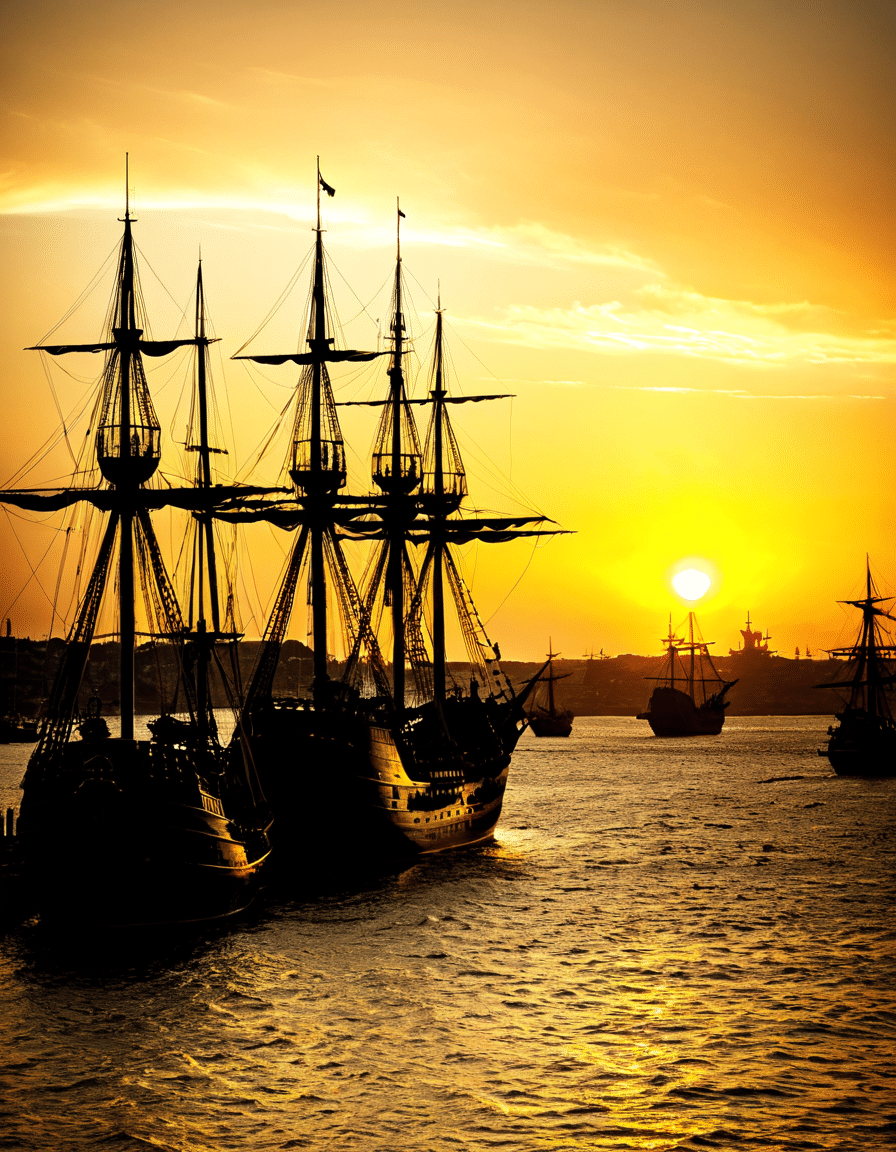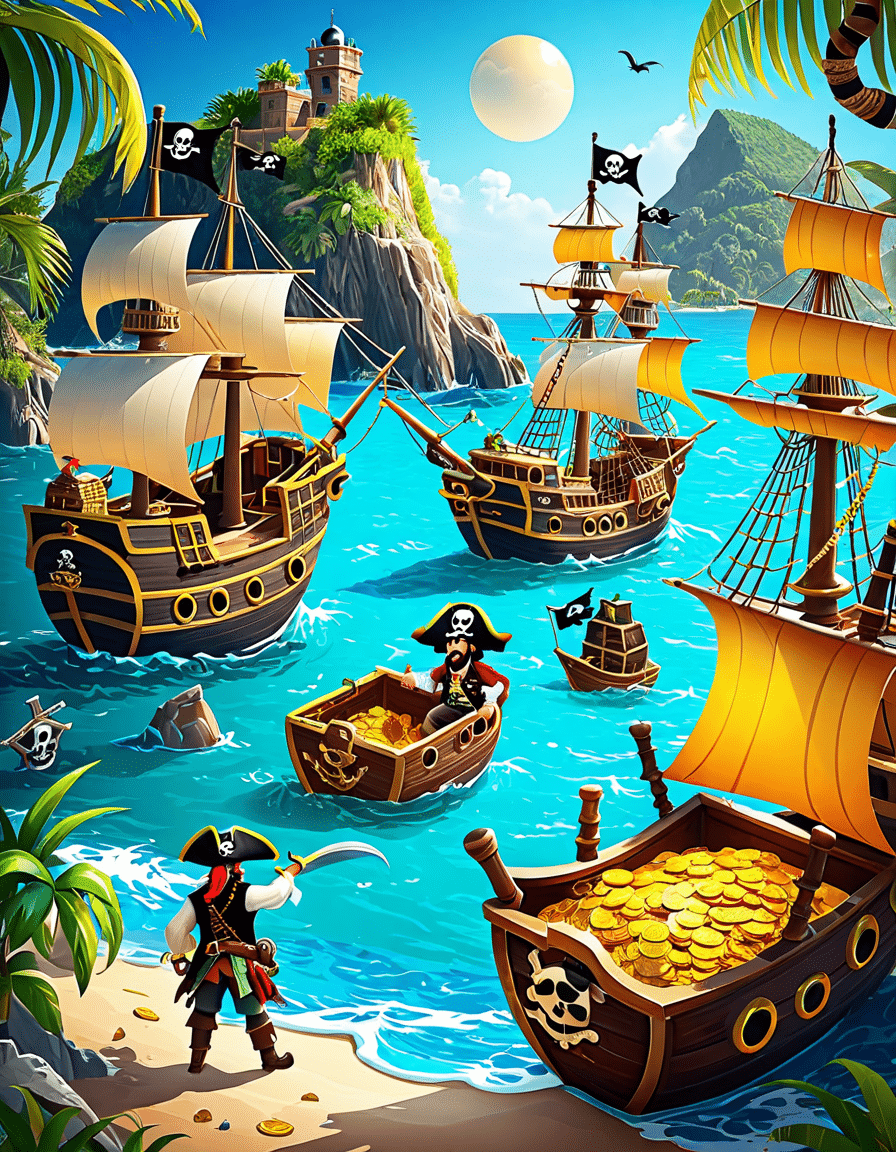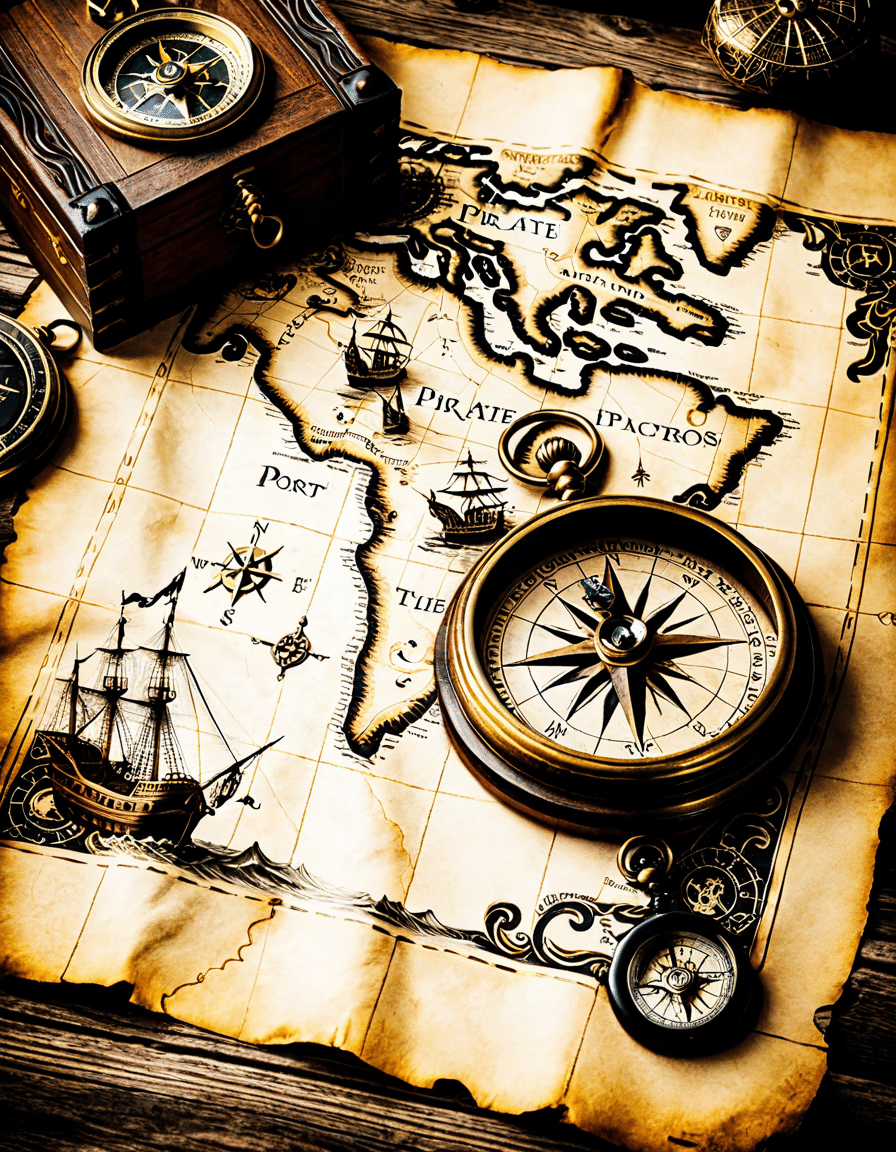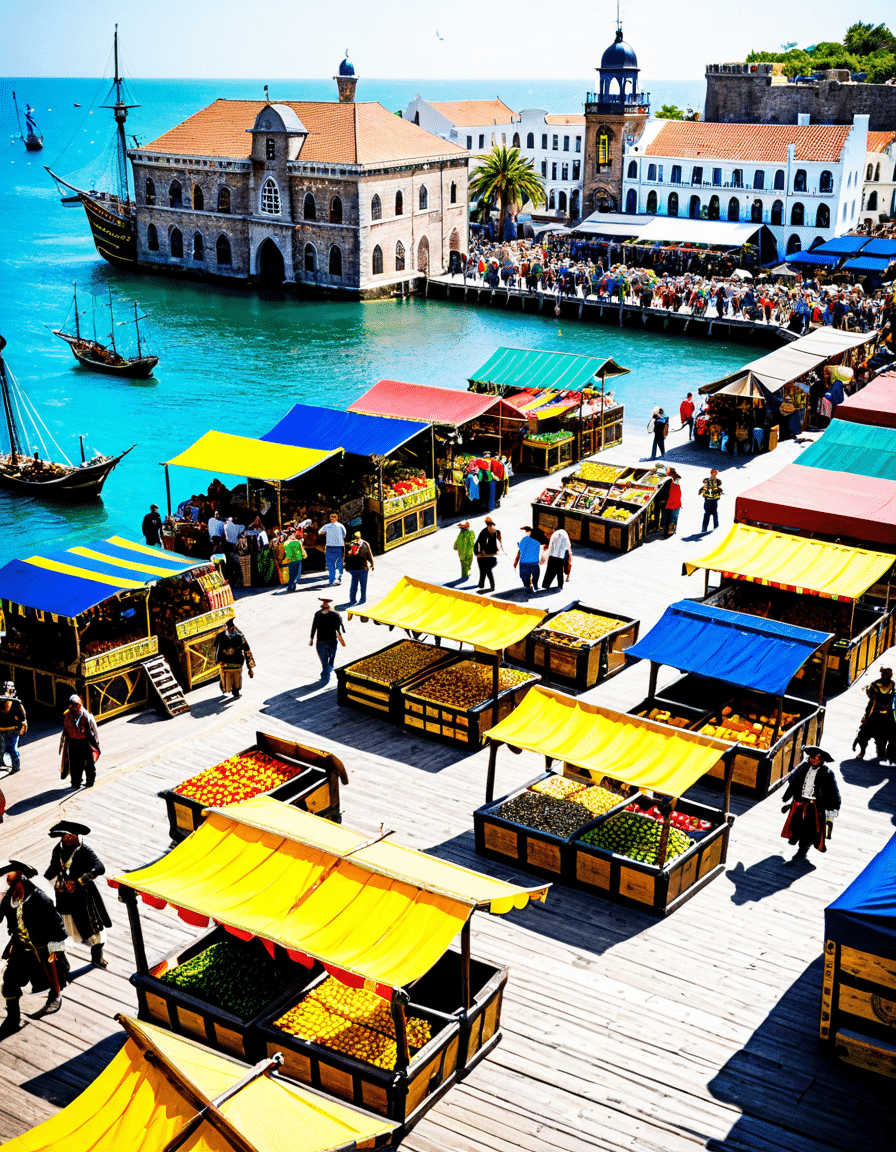Pirate ports—their mystique delivers a combination of adventure, rebellion, and a touch of romanticism. They’ve danced through the pages of history books, tales of swashbuckling rogues and treasure hunters, igniting our imaginations for centuries. In this journey across the seven seas, we delve into the secrets these legendary pirate ports reveal about our shared past, offering insights that spark curiosity and conversation. So, hoist the sail, and let’s embark on an exploration of these infamous locales that changed maritime history.

Unraveling the Mystique of the Pirate Port
The allure of pirate ports is undeniable. When one mentions places like Tortuga or Nassau, images of taverns filled with raucous laughter and hidden treasures come to mind. But what lies beneath the surface of these storied sites is a rich tapestry woven with cultural intermingling and economic significance, often overlooked in the narrative of piracy. Each pirate port became a unique hub, significantly influencing the regions around them and often serving as a melting pot of various cultures and customs.
Why did these ports gain such notoriety? It’s simple. They provided a safe haven for pirates—a place where the law was distant and fortune awaited. Add to this the fact that these ports often became bustling centers of trade and contact among diverse peoples. Pirate ports were not just places to stash stolen loot; they were vibrant environments that played pivotal roles in shaping maritime history.
If you’re a fan of tales that intertwine with the mystique of the sea, then understanding the nature of these ports provides a deeper appreciation of not just who the pirates were, but also what the world looked like during the era of buccaneering adventures. Their stories intertwine with the legs of history, showcasing a blend of greed, ambition, and the continual human quest for freedom.

Top 7 Pirate Ports That Changed Maritime History
1. Tortuga, Haiti: The Buccaneers’ Paradise
Tortuga stands out as the quintessential pirate stronghold of the Caribbean in the 17th century. With its hidden coves and lively taverns, it became a haven for buccaneers. Historical records reveal that Tortuga was not just a base for rampant plunder; it became a nexus for cultures, blending the lives of pirates with local populations, forging language and customs that still hold influence today.
The vibrant life in Tortuga was akin to a speculative playground where fortunes were made and lost. It was a breeding ground for some of the most infamous pirates, driving tales that have continued to permeate popular culture.
2. Nassau, Bahamas: The Republic of Pirates
Nassau’s notoriety spread like wildfire in the early 1700s. This bustling pirate port attracted legends like Blackbeard and Charles Vane, who roamed its streets without fear of the law. The area practically pulsated with stories of adventure, rebellion, and treachery, allowing its residents and visitors to delve into a time when the spirit of piracy thrived.
Even today, Nassau embraces its bold history, offering museums and tours that allow us to step back in time and explore its vibrant pirate legacy.
3. Port Royal, Jamaica: The Sodom of the New World
Once dubbed “the richest and most wickedest city on Earth,” Port Royal was the beating heart of Caribbean piracy in the late 17th century. Unfortunately, its prosperity came to an abrupt end in 1692 when an earthquake swallowed much of the city whole. This disaster serves as a cautionary tale—a reflection of a life lived in excess.
Underwater explorations continue to uncover treasures and remnants of pirate life, showcasing Port Royal’s secretive past and revealing the intersection of wealth and lawlessness.
4. Gibraltar: The Strategic Powerhouse
Gibraltar, an intriguing locale, is better known today as a British Overseas Territory. But in the pirate era, it played a crucial role as a strategic port. Positioned at the crossroads of the Atlantic and the Mediterranean, Gibraltar served as a vital stop for ships maneuvering through perilous trade routes.
Modern research emphasizes Gibraltar’s significant role—not only as a sanctuary for pirates but also as an influential player in the maritime trade dynamics that shaped this period.
5. Cascais, Portugal: The Hidden Gem
Often forgotten in discussions about pirate ports, Cascais was notably active during the Age of Sail, serving as a launch point for many infamous raids. This picturesque town offered a glimpse into the piratical activities of its day, facilitating connections between coastal Africa and the Americas.
While it today reflects tranquility and charm, Cascais did much more than just bewitch travelers—it helped lay the foundation for various piratical enterprises in its time.
6. Dahomey (Benin) Coast: Africa’s Pirate Port
When most folks picture piracy, they think of European waters, but the Dahomey Coast adds a compelling chapter to the story. It was infamous for its involvement in the slave trade—a harsh reality that showcases a different facet of piracy. The complex relationship between European traders and local rulers highlights the intricate dynamics of power and greed during this era.
Wading through the narratives of this coast reveals a rich and often overlooked aspect of pirate culture, reshaping how we view maritime history.
7. Bristol, England: The Smuggler’s Haven
Bristol wasn’t just a trade hub; it emerged as a bustling center for privateering and smuggling. With deep maritime roots, its waters fostered notable figures who expertly danced along the fine line between legitimate business and piracy.
Current studies unravel how Bristol’s legacy intertwined with burgeoning naval practices, offering valuable lessons from its robust history.
The Cultural Impact of Pirate Ports
The unique footprints left by pirate ports extend well beyond their economic contributions. They’ve inspired a rich vein of folklore, literature, and cinema, resonating with audiences worldwide. Museums, such as the Pirate Museum in Key West and the Discovery Museum in Portsmouth, UK, curate artifacts that represent this adventurous spirit. These institutions encapsulate the thrill of rebellion and adventure, bringing stories of lawlessness to life.
Why Do We Care?
The narratives of pirate ports tap into something fundamental about human nature—adventure, freedom, and daredevil spirit. Movies and books immortalize these tales, compelling generations to delve deeper into the lives of those pirates who dared to defy authority. Indeed, the essence of what lies within these stories has become part and parcel of our cultural fabric, thrilling audiences even in contemporary settings.
Rediscovering Pirate Ports in Modern Times
Today, pirate ports continue to captivate people all around the globe, transforming their historical allure into modern tourism. Guided tours, historical reenactments, and treasure hunts help bridge the gap between past and present. Each visit offers a unique perspective on a time filled with daring exploits and reckless abandon.
As reality catches up with fantasy, archaeological dives into these historic sites unveil new treasures and insights. Each discovery makes waves, deepening our awareness of piracy’s lasting influence on society and navigating our understanding of cultural narratives.
Reflecting on the Resilient Legacy of Pirate Ports
The tales woven through the fabric of pirate ports aren’t just relics of a forgotten time; they embody a blend of culture, ambition, and the unquenchable thirst for adventure. Their enduring legacies inspire curiosity that surpasses generations, inviting those who seek deeper stories hidden within the folds of history.
Pirate ports represent a unique storytelling medium—an intricate tapestry of adventure, lawlessness, and cultural exchange that resonates through the years. As we reflect on their influence, we’re reminded of not only the piracy that thrived but also the world’s complexities during a time of both innovation and chaos.
So, the next time you stumble across a story of pirates or their ports, you’ll recognize that these tales go beyond the romanticism—they’re rich with history and cultural convergence waiting to be unraveled.
For more in-depth takes on eclectic topics, check out our articles on corporate Campuses or perhaps immerse yourself in the magic of Joseph And The Amazing technicolor Dreamcoat. With every read, let’s keep exploring the world around us.
Pirate Port Secrets That Will Blow Your Mind
The Underbelly of Pirate Ports
Did you know pirate ports were often bustling trade hubs? Beyond the swashbuckling tales of treasure and adventure lay intricate networks of commerce and craft. Pirates didn’t just raid ships; they also engaged in bartering and trading goods. For instance, the infamous Pirate’s Cove was not just a hideout, but a booming marketplace for plundered goods. So, if you ever fancy trying your hand at a pirate-themed game, you might want to check out some fun alternatives like those offered by Silvergames.
Moreover, many pirate crews had their own unique traditions. They often dined on culinary concoctions that maintained their energy; surprisingly, some of those meals included low calorie high volume Foods. With limited provisions at sea, they had to make every bite count! Talk about resourcefulness.
The Intriguing Lives of Pirate Port Residents
Ever wondered what life looked like for those who lived near a pirate port? Many residents lived in constant fear of raids and battles. Nevertheless, pirate ports were also melting pots of culture where art flourished. An intriguing aspect is how local artists would often create pieces inspired by the daring escapades of the pirates, a nod to the influence of underground arts in these communities. You might say these ports were the creative epicenters of their time, as art and piracy engaged in a wild dance.
And speaking of excitement, do you know that pirate ports also fostered unusual animal lore? Among them, the notorious ruby snake was often said to be a companion to many a scallywag. They believed spotting one could either bring you fortune or misfortune, depending on the tale told that day. Isn’t that a wild way to keep things lively?
The Evolution of a Pirate Port
As piracy grew, so did the influence of the ports. Their significance dwindled as nations cracked down on pirate activities, but remnants of pirate culture linger. For example, the shift in population led to a peculiar trash culture—enter republic trash. You’d be surprised what went into the ports; everything from fancy loot to everyday scraps created a mosaic of stories waiting to be uncovered.
And while pirates may be known for their sword fights, one of their drills included fitness routines which today resemble modern workouts like the devil press. Who would’ve thought your favorite gym exercises have roots in pirate training? The world of piracy offers surprising connections, unfolding tales both fascinating and fun! From notorious pirate port tales to unexpected fitness trivia, there’s much to discover in this adventurous slice of history.






















